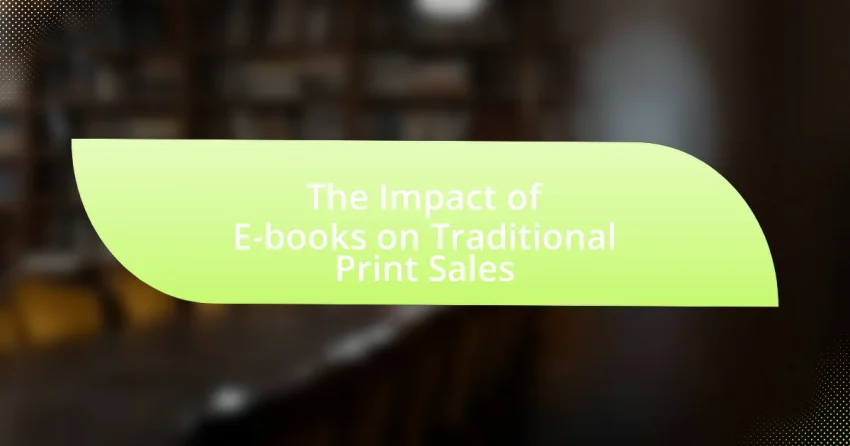The article examines the impact of e-books on traditional print sales, highlighting a significant decline in physical book purchases as e-books gained popularity, accounting for approximately 20% of the total book market in 2020. It discusses how e-books have transformed consumer reading habits by increasing accessibility and convenience, particularly among younger demographics and diverse ethnic groups. The economic implications of this shift are explored, including the lower prices of e-books compared to print books and the resulting changes in publishing strategies. Additionally, the article addresses the enduring preference for print books due to their tactile experience and emotional connection, while also considering future trends and strategies for publishers to balance both formats effectively.

What is the impact of e-books on traditional print sales?
E-books have negatively impacted traditional print sales by contributing to a decline in physical book purchases. According to a report by the Association of American Publishers, e-book sales accounted for approximately 20% of the total book market in 2020, which correlates with a decrease in print book sales. Additionally, a study published in the Journal of Electronic Publishing found that the rise of e-books has led to a shift in consumer preferences, with many readers opting for the convenience and lower prices of digital formats over traditional print. This trend indicates a significant transformation in the publishing landscape, where e-books are increasingly favored, resulting in reduced demand for printed books.
How have e-books changed consumer reading habits?
E-books have significantly changed consumer reading habits by increasing accessibility and convenience. With the ability to store thousands of titles on a single device, readers can easily access a wide range of books anytime and anywhere, leading to an increase in reading frequency. A study by the Pew Research Center in 2021 found that 27% of Americans reported reading an e-book in the past year, highlighting a shift from traditional print formats. Additionally, e-books often come with features such as adjustable font sizes and built-in dictionaries, which enhance the reading experience and cater to diverse preferences. This shift has contributed to a decline in traditional print sales, as consumers increasingly opt for the digital format for its practicality and immediacy.
What demographic shifts are evident in e-book readership?
E-book readership has seen significant demographic shifts, particularly among younger audiences and diverse ethnic groups. Research indicates that individuals aged 18 to 29 are the most active e-book readers, with 28% of this age group reporting regular e-book consumption, according to a 2021 Pew Research Center study. Additionally, e-book readership has increased among Hispanic and Black populations, reflecting a broader trend towards digital reading formats in these communities. This shift is supported by the rise of mobile devices and e-readers, which have made access to e-books more convenient and appealing across various demographics.
How do e-books influence the frequency of reading among consumers?
E-books significantly increase the frequency of reading among consumers by providing convenient access to a vast library of titles. Research indicates that the portability and accessibility of e-books encourage more frequent reading sessions, as users can carry multiple books on a single device and read anytime, anywhere. A study by the Pew Research Center found that 28% of e-book readers read more books than they did before adopting e-books, highlighting a direct correlation between e-book usage and increased reading frequency. Additionally, features such as adjustable font sizes and built-in dictionaries enhance the reading experience, making it more engaging and user-friendly.
What are the economic implications of e-books on print sales?
E-books have significantly impacted print sales by contributing to a decline in physical book purchases. According to a report by the Association of American Publishers, e-book sales accounted for approximately 20% of the total book market in 2020, leading to a decrease in print book sales by around 10% in the same year. This shift indicates that consumers are increasingly opting for digital formats due to factors such as convenience, lower prices, and accessibility. Additionally, the rise of e-books has prompted traditional publishers to adapt their business models, often resulting in reduced print runs and changes in marketing strategies to accommodate the growing digital market.
How do e-book prices compare to traditional print book prices?
E-book prices are generally lower than traditional print book prices. For instance, the average price of an e-book is around $9.99, while print books often range from $15 to $30, depending on factors like format and publisher. This price difference is attributed to lower production and distribution costs associated with e-books, as they do not require physical materials or shipping. Additionally, a study by the Association of American Publishers indicated that e-book sales have consistently undercut print sales, reflecting consumer preference for more affordable digital options.
What trends are observed in print book sales since the rise of e-books?
Since the rise of e-books, print book sales have experienced a notable decline, particularly in the early 2010s, with a reported drop of approximately 30% in sales volume from 2007 to 2013. This trend has been attributed to the increasing popularity of digital formats, which offer convenience and often lower prices. However, recent data indicates a stabilization in print book sales, with a resurgence observed in specific genres such as hardcover fiction and non-fiction, which saw a 5% increase in sales in 2020 compared to the previous year. This shift suggests that while e-books have disrupted traditional print sales, there remains a resilient market for print books, particularly among dedicated readers and collectors.
Why are some readers still choosing print over e-books?
Some readers still choose print over e-books due to the tactile experience and emotional connection associated with physical books. Research indicates that 70% of readers prefer the sensory aspects of print, such as the feel of the pages and the smell of the paper, which enhance their reading experience. Additionally, print books do not require electronic devices or batteries, making them more accessible in various environments. Studies have shown that print books can improve retention and comprehension, with readers recalling information better when reading from paper compared to screens.
What factors contribute to the preference for print books?
The preference for print books is primarily influenced by tactile experience, nostalgia, and perceived value. Readers often appreciate the physical feel of a book, which enhances engagement and retention of information. Studies indicate that tactile interaction with print materials can improve memory recall, as evidenced by research published in the journal “Psychological Science,” which found that students who read on paper performed better on comprehension tests than those who read digitally. Additionally, the nostalgia associated with print books contributes to their appeal, as many readers have fond memories tied to physical books, reinforcing their preference. Lastly, print books are often perceived as more valuable due to their tangible nature and the aesthetic appeal of physical collections, which can enhance the reading experience.
How does the tactile experience of print books affect reader choice?
The tactile experience of print books significantly influences reader choice by enhancing engagement and emotional connection. Readers often prefer the physicality of print books, as the texture, weight, and smell contribute to a multisensory experience that digital formats cannot replicate. Research indicates that tactile interaction with print materials can improve memory retention and comprehension, making readers more likely to choose print over digital options. A study published in the journal “Psychological Science” by Patricia A. Alexander and colleagues found that physical books facilitate deeper cognitive processing compared to e-books, reinforcing the preference for print among certain demographics.

What are the key factors driving the e-book market?
The key factors driving the e-book market include technological advancements, increasing smartphone and tablet penetration, and changing consumer preferences. Technological advancements have made e-books more accessible and user-friendly, allowing readers to easily download and read books on various devices. The rise in smartphone and tablet usage, with over 3.8 billion smartphone users globally as of 2021, has facilitated the consumption of digital content. Additionally, consumers increasingly prefer the convenience and portability of e-books, as evidenced by a 2022 survey indicating that 60% of readers enjoy the ability to carry multiple books in one device. These factors collectively contribute to the growth and popularity of the e-book market.
How does technology influence the growth of e-books?
Technology significantly influences the growth of e-books by enhancing accessibility, convenience, and interactivity. The proliferation of smartphones, tablets, and e-readers has made it easier for consumers to access a vast library of e-books anytime and anywhere. According to a report by the Association of American Publishers, e-book sales in the U.S. reached $1.1 billion in 2020, reflecting a growing trend driven by technological advancements. Additionally, features such as adjustable font sizes, built-in dictionaries, and multimedia elements improve user experience, further promoting e-book adoption. These technological innovations not only cater to diverse reading preferences but also facilitate the distribution and marketing of e-books, contributing to their increasing popularity in the digital age.
What role do e-readers and apps play in e-book accessibility?
E-readers and apps significantly enhance e-book accessibility by providing customizable reading experiences that cater to diverse user needs. These devices and applications offer features such as adjustable font sizes, background colors, and text-to-speech capabilities, which accommodate individuals with visual impairments or reading difficulties. For instance, studies indicate that e-readers can improve reading speed and comprehension for users with dyslexia due to their ability to modify text presentation. Furthermore, e-books can be easily downloaded and accessed instantly, eliminating barriers related to physical availability and distribution, thus broadening access to literature for a wider audience.
How has the internet changed the distribution of e-books?
The internet has revolutionized the distribution of e-books by enabling instant access and global reach for both authors and readers. This transformation allows authors to publish and distribute their works without the need for traditional publishing houses, significantly reducing costs and time associated with print publishing. According to a report by the Association of American Publishers, e-book sales in the U.S. reached approximately $1.1 billion in 2020, illustrating the growing market facilitated by online platforms. Additionally, platforms like Amazon Kindle and Apple Books have created ecosystems where readers can easily purchase and download e-books, further enhancing accessibility and convenience.
What marketing strategies are effective for e-books?
Effective marketing strategies for e-books include leveraging social media advertising, utilizing email marketing campaigns, and offering promotional pricing or discounts. Social media platforms like Facebook and Instagram allow targeted ads that can reach specific demographics, increasing visibility and engagement. Email marketing enables direct communication with potential readers, fostering relationships and encouraging purchases through personalized content. Additionally, promotional pricing strategies, such as limited-time discounts or bundling with other e-books, can create urgency and drive sales. According to a study by the Book Industry Study Group, e-books accounted for 20% of book sales in 2020, highlighting the importance of effective marketing in this growing sector.
How do social media and online platforms impact e-book sales?
Social media and online platforms significantly enhance e-book sales by providing targeted marketing opportunities and facilitating direct engagement with readers. These platforms allow authors and publishers to reach specific demographics through advertising and organic content, increasing visibility and driving sales. For instance, a study by the Pew Research Center found that 72% of adults use social media, which can be leveraged to promote e-books effectively. Additionally, platforms like Goodreads and Amazon enable user reviews and recommendations, which influence purchasing decisions and contribute to higher sales volumes.
What promotional tactics are successful in attracting e-book readers?
Successful promotional tactics for attracting e-book readers include offering limited-time discounts, utilizing social media marketing, and implementing email marketing campaigns. Limited-time discounts create urgency, encouraging potential readers to make a purchase; for instance, a study by the Book Industry Study Group found that 60% of e-book buyers are influenced by price promotions. Social media marketing leverages platforms like Facebook and Instagram to reach targeted audiences, with 74% of consumers relying on social networks for purchasing decisions, according to a report by HubSpot. Email marketing campaigns, which can yield an average return on investment of $42 for every dollar spent, allow publishers to directly engage with readers and promote new releases or exclusive content. These tactics effectively increase visibility and drive sales among e-book readers.

What are the future trends for e-books and print sales?
The future trends for e-books and print sales indicate a continued growth in e-book popularity while print sales are expected to stabilize or decline slightly. E-books are projected to account for a larger share of the overall book market, driven by increasing digital consumption and advancements in technology, such as improved e-readers and mobile devices. According to a report by the Association of American Publishers, e-book sales grew by 16.5% in 2020, highlighting a shift in consumer preferences towards digital formats. Conversely, print sales, while still significant, are facing challenges from this digital shift, with a slight decrease in sales reported in recent years. The trend suggests that while e-books will dominate, print will maintain a loyal customer base, particularly among certain demographics who prefer physical books.
How might the relationship between e-books and print evolve?
The relationship between e-books and print is likely to evolve towards a coexistence model, where both formats serve distinct purposes for readers. E-books offer convenience and accessibility, appealing to tech-savvy consumers and younger demographics, while print books continue to attract readers who value tactile experiences and aesthetics. According to a 2021 report by the Association of American Publishers, e-book sales accounted for 20% of the overall book market, indicating a significant but not dominant presence. This trend suggests that while e-books may capture a growing share of the market, print books will maintain their relevance due to their unique attributes, leading to a diversified reading landscape.
What innovations could reshape the e-book landscape in the coming years?
Innovations such as enhanced interactivity, artificial intelligence integration, and augmented reality features could reshape the e-book landscape in the coming years. Enhanced interactivity allows readers to engage with content through multimedia elements, making reading more immersive. Artificial intelligence can personalize reading experiences by recommending content based on user preferences and reading habits, thereby increasing user engagement. Augmented reality features can provide interactive visualizations and supplementary information, enriching the reading experience. These innovations are supported by trends in technology adoption, with a significant increase in user demand for interactive and personalized content in digital formats.
How might consumer preferences shift in the future?
Consumer preferences are likely to shift towards digital formats, particularly e-books, as technology advances and convenience becomes a priority. Research indicates that e-book sales have consistently increased, with a 2020 report from the Association of American Publishers showing a 16.5% rise in e-book revenue compared to the previous year. This trend suggests that consumers are increasingly valuing the accessibility and portability of digital content over traditional print formats. Additionally, younger generations, who are more tech-savvy, are expected to drive this shift further, as they tend to prefer reading on devices rather than physical books.
What strategies can publishers adopt to balance e-books and print sales?
Publishers can adopt a multi-channel distribution strategy to balance e-books and print sales effectively. This approach involves offering both formats simultaneously and leveraging their unique advantages. For instance, publishers can use targeted marketing campaigns to promote e-books during seasonal sales or special events, while also highlighting the tactile experience and collectible nature of print books to appeal to traditional readers.
Additionally, implementing pricing strategies that differentiate between e-books and print editions can help manage consumer preferences; for example, offering e-books at a lower price point can attract price-sensitive readers, while maintaining print prices to reflect production costs. Research indicates that 30% of readers prefer e-books for convenience, while 70% still value print for its physical presence, demonstrating the need for a balanced approach.
By analyzing sales data and reader preferences, publishers can adjust their inventory and marketing efforts to optimize sales across both formats, ensuring that neither e-books nor print editions cannibalize each other’s market share.
How can publishers leverage both formats to maximize revenue?
Publishers can leverage both e-books and traditional print formats to maximize revenue by implementing a dual-distribution strategy that targets diverse consumer preferences. This approach allows publishers to reach a broader audience, as some readers prefer the convenience and portability of e-books, while others value the tactile experience of print books. According to a report by the Association of American Publishers, e-book sales accounted for approximately 20% of the overall book market in 2022, indicating significant consumer interest in digital formats. By offering both formats, publishers can cater to these varying preferences, thereby increasing overall sales and revenue. Additionally, bundling e-books with print editions can incentivize purchases, further enhancing revenue potential.
What best practices should be followed for marketing both e-books and print books?
To effectively market both e-books and print books, authors and publishers should utilize a multi-channel approach that includes social media, email marketing, and targeted advertising. Social media platforms like Facebook and Instagram allow for direct engagement with readers, while email marketing can be used to build a loyal audience by providing exclusive content and updates. Targeted advertising on platforms such as Amazon and Google can reach specific demographics interested in the book’s genre. According to a 2021 survey by the Book Industry Study Group, 70% of readers discover new books through social media, highlighting its importance in marketing strategies. Additionally, offering promotions or discounts for both formats can incentivize purchases and increase visibility.
